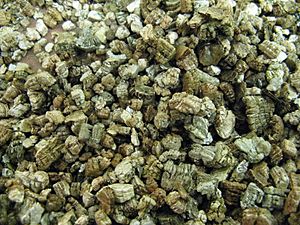Vermiculite facts for kids
Vermiculite is a special mineral that people dig out of the ground. It's a type of silicate mineral. You can find it in countries like China, South Africa, Russia, and Brazil. When it's first dug up, it looks like a hard rock. But something amazing happens when you heat it up! It gets much bigger and changes into a light, fluffy material that looks a bit like tiny worms. People first discovered this cool trick in the United States in 1824.
Contents
What is Vermiculite?
Vermiculite is a natural mineral. It's part of a group of minerals called phyllosilicates. This means it has a layered structure, almost like a stack of thin sheets. When this rock is heated very quickly, the water trapped between its layers turns into steam. This steam makes the layers separate and puff up, causing the vermiculite to expand a lot. This expanded form is what we use for many different things.
How is Vermiculite Used?
Expanded vermiculite has many helpful uses because of its special properties. It's light, can hold water, and is good at stopping heat and fire.
Keeping Things Warm or Cool
Because expanded vermiculite has lots of tiny air pockets, it's great for insulation. This means it can help keep heat in or out. It's used to insulate things like:
- Ovens and furnaces, to keep them hot.
- Houses, especially in cold places, to keep the warmth inside.
- Roofs and walls, to make buildings more energy-efficient.
Helping Plants Grow
Vermiculite is very good at soaking up and holding water, like a sponge. This makes it super useful for gardening:
- It's often mixed into the soil for plants in pots. It helps the soil stay moist for longer, so plants don't dry out as quickly.
- It's also used to help seeds sprout and grow strong. The light texture helps young roots spread easily.
- In hydroponics, where plants grow without soil, vermiculite can be a stable material for plant roots to hold onto.
Protecting Items During Travel
The expanded grains of vermiculite are soft and spongy. You can press them flat, and they'll bounce back to their original shape. This makes them perfect for protecting fragile items. They are often used inside boxes or cases to cushion things like electronics or glassware during shipping, stopping them from breaking.
Stopping the Spread of Fire
One of the best things about vermiculite is that it doesn't burn. Because of this, it's used with other materials in buildings to make them safer from fire. You might find it in the fillings of walls or ceilings, where it helps to slow down or stop the spread of fire from one room to another.
Important Safety Note
While vermiculite itself is safe, sometimes the places where it's dug up can also have another mineral called asbestos. Asbestos can be harmful if its tiny fibers are breathed in. Because of this, if you ever see vermiculite insulation in an old building, it's important to be careful. It's best to assume it might contain asbestos until a special lab checks it and says it's safe.
Images for kids
See also
 In Spanish: Vermiculita para niños
In Spanish: Vermiculita para niños



